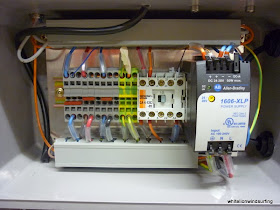 |
| The "Smart Little Sucker" |
With a few board designs in the pipeline it was time to upgrade my vacuum pump to a system with vacuum pressure control. Up until know I have used the cheap fridge pump option and while you may save a lot of money on the initial outlay you soon loose money if you damage a blank(or 2 as I did!!!!) using excessive vacuum pressure. The vacuum pressure control is achieved by using a tee fitting with a ball valve in combination with a vacuum gauge. While this setup may be good for small bagging jobs and high vac pressures with robust moulds I have had problems bagging boards where the vacuum pressure is stable for several hours and then a leak or hole suddenly seals itself and the pressure goes throught the floor(really low ;). Since the vacuum has to be maintained for 12 hours or so this makes bagging overnight risky.
 |
| My old fridge pump system. |
 |
| The pump was fan cooled on big jobs. |
The next step up from using a ball valve is a diaphragm and reed switch but I am not a fan of this version due to the lack of precise control as well as questionable electrical safety.
I wanted precise vacuum control without the pump having to run continuously and came across this veneer vacuum system from Veneer Supplies.Com:
http://www.veneersupplies.com/products/Project-EVS-Auto-Cycling-Pump-Vacuum-Press-Kit.html
I was able to scrounge most of the required components from the parts bin at work except for a vacuum controller. I decided to use an SMC electronic vacuum switch for accurate control and the hysteresis function to reduce frequent pump switching.
The need for a small footprint as well as portability meant than I had to stack the components using a plywood shelf system. This is the prototype which will probably stay this way - functional!
Working from the Air Fitting back there is a ball valve to isolate the system from the vacuum bagging line. The ball valve is connected to the vacuum reservoirs(tubes of nothingness...) which are separated by a takeoff for the vacuum switch.
 |
| Vacuum Reservoirs. |
The reservoirs are then connected to a check valve(one way valve) to store the vacuum in the reservoirs.
 |
| Top view of Vacuum Reservoirs, Vacuum switch and Check Valve. |
Connected to the check valve is a 3 way solenoid valve to relieve the vacuum pressure behind the check valve when the pump is switched off by the vacuum switch. This stops the pump having the start under load. Next up is a under bench water filter which acts as both a line filter and sub reservoir. The sub-reservoir allows the pump the run to full RPM without back pressure on the pump intake port. Connected to the filter is a small diaphragm pump which is oil free and super quiet when an exhaust muffler is fitted.
 |
| 3 Way Valve, Sub-reservoir/Filter and Pump. |
Below the pump is a small termination box housing the terminals, 24v Power Supply and Contactor. The Vacuum switch outputs a signal to the contactor which switches off the pump and opens the exhaust valve at the desired vacuum pressure.
 |
| Terminals, Contactor and 24V P.S. |
Next up is a test run on a new board or 2!





















